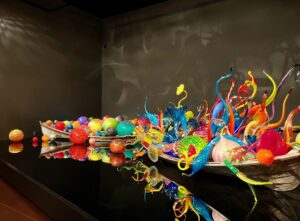
The Ultimate Guide to
Planning A Trip to Yellowstone
Microbial Mats, Yellowstone. Photo by Trip Scholars
This post may contain affiliate links which means Trip Scholars may make a small commission (at no extra cost to you) if you make a purchase. As an Amazon Associate I earn from qualifying purchases. Read more here. Thanks for helping us keep the lights on!
Visiting Yellowstone National Park can be one of life’s most treasured experiences. The place is so extraordinary that it inspired the creation of the world’s first national park and it was one of the initial UNESCO sites! Your time in the park will be limited, but you can begin enhancing your trip today by learning more about this remarkable area. Planning a trip to Yellowstone can be a long and joyful endeavor and we have gathered the best resources to help you make the most of your visit to this incredible park. This is a different kind of travel guide offering you many ways to learn much more about the park. We promise, it will be worth your while!
What is the best way to plan a trip to Yellowstone National Park?
The best way to plan a trip to Yellowstone is to take the time to learn about it in advance. By discovering more, you will be able to create your own personalized itinerary. You will also cultivate a deeper understanding and appreciation of the natural wonders that you will see.
The best things to see in Yellowstone are the wildlife and the geology, especially the geothermal features. We will highlight helpful resources to learn more about each of these. We will also offer many other resources to enjoy from home before you go so you and your travel companions can be intentional and well researched visitors to the park.
I am a former science teacher and I have visited Yellowstone dozens of times since my family lived nearby. I have used many resources over the years that have made my visits to the park some of my greatest life experiences and I have brought the best together here to save you time and money in finding them.
Map of Yellowstone
Sites referenced in the article are labeled on the map.
What are the main attractions of Yellowstone?
The main attractions in the park are the unique geologic features throughout the park, especially the geothermal wonders and the abundant wildlife. Let’s look at each of them in turn. When you look at a map of the park, you will notice there is a large figure eight road with offshoots leading out of the park. This is known as the Grand Loop Road, and you will refer to it often throughout your trip planning. We will be highlighting sites along this road since they are the main attractions in the park.
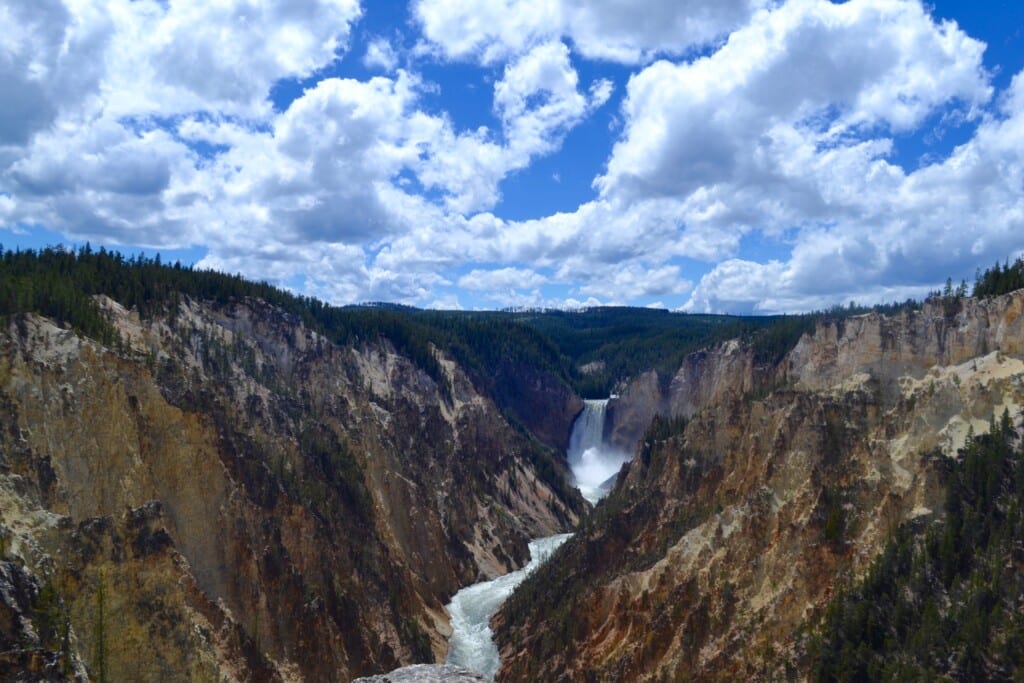
Yellowstone Geology and Thermophiles
The extraordinary and unique features of the park are all directly related to the geologic story of the region. The Rocky Mountains rose up 55-80 million years ago and can be enjoyed through visits to the adjacent Grand Teton National Park and nearby Glacier National Park or Rocky Mountain National Park. If you can include additional time on your trip, we recommend visiting any of these dramatic areas in the Rocky Mountain system.
The Yellowstone Volcano
The Rocky Mountains radiate from the park, but much of what visitors see while in Yellowstone is related to more recent chapters in the geologic story. Yellowstone is over a hot spot, an area on our planet where the crust is very thin. At the Yellowstone hotspot the magma is about three miles below the surface. (Think of the last three mile walk you took. It is that close!) In most other places on the continental crust the magma is 20-30 miles below the surface.
As the North American tectonic plate has gradually moved, the hotspot has been under different areas. Sixteen-million years ago it was under the Columbia Plateau in Oregon. Interested travelers will be thrilled with the examples of volcanic phenomena related to this hotspot that they will see on a well-planned road trip to the PNW from Yellowstone.
When this hotspot moved under what is now Yellowstone there was enormous volcanic activity, and the Yellowstone Super volcano came into being. The Yellowstone plateau was created over two million years and included two of the largest known eruptions on the planet. This plateau was created after eruptions when the massive magma chamber emptied and collapsed. Plateaus were created after each of the major eruptions, leaving noticeable highlands above the rest of the park. The most recent caldera encompasses the whole southern end of the Grand Loop Road. It is mind boggling to look around through your travels in the park and realize you are inside of a massive caldera! The last major eruption was 640,000 years ago and no magmatic eruptions have occurred for 70,00 years.
Some of the best things to see in Yellowstone are directly related to these ancient volcanic roots. Sheepeater’s Cliff in the northwest part of the park is a stunning example of columnar basalt. The Grand Canyon of the Yellowstone is one of the most spectacular canyons in the U.S. and is a must-see stop on your drive through the Grand Loop Road. The “yellow” stone dramatically framing the falls from Artist’s Point is from the stone rhyolite, a type of lava that erupted during one of the major volcanic phases. The dramatic range of colors along the canyon walls were made by hydrothermally altered rhyolite and sediments. The sculpting by the Yellowstone River through this yellow stone is a much more recent phenomenon. The river drops over 400 feet (more than Niagara Falls!) between the top of Upper Falls and the bottom of Lower Falls. The canyon itself is over 20 miles long and the wild Yellowstone River at the bottom is the longest free flowing river in the contiguous United States.
Yellowstone Earthquakes
Many visitors are concerned about earthquakes in the area. There are an extraordinary 1000-3000 earthquake tremors a year, making it one of the most seismically active areas in the country. Most of these quakes are not noticeable to visitors and it is unlikely you will feel any seismic activity on your visit. The last major earthquake in the region was at Hebgen Lake (7.5) in 1959 and created Quake Lake, not far outside of the West Yellowstone Entrance. Those interested in geology will find it worth the drive if their travels bring them west of the park.
Here are two excellent websites to learn more about earthquakes in the Yellowstone area.
USGS Yellowstone Volcano Observatory
The United States Geological Survey site is obviously comprehensive and thorough. You can read a brief but fascinating geologic history of the area, stay up to date with recent news and visit the monitoring map for a staggering window into how active the area actually is.
This is a much simpler website that makes it easy for the general public to track earthquakes around the world. Small tremors are not registered, but you can easily see how active the Yellowstone Volcano has been today!
Yellowstone Geothermal Features
Among the best things to see in Yellowstone are the geothermal features. The park has half of all of them in the world and boasts the largest collection of varied hot water features on earth! There are 10,000 thermal features in the region and they include geysers, mud pots, travertine terraces, hot springs, and fumaroles. They are all caused by underground water interacting with the intense heat caused by proximity to the mantle throughout this hot spot.
The differences in features are primarily related to the underground plumbing, the minerals involved, and the quantity of water. Much of the water in the park is alkaline and when it reacts with rocks underground, it lines the cracks with silica, creating natural underground plumbing.
Yellowstone Geysers
Geysers have a constriction below ground where the hot water pressurizes until it finally gives way and the geyser erupts, often creating one of the greatest spectacles on the planet.
Geysers are one of the best things to see in Yellowstone National Park. Even people who are only able to visit the park for one day will stop at Old Faithful Geyser. The underground plumbing allows people from all over the planet to gasp in unison at its majesty on a very predictable eruption schedule, rightfully earning it the name Old “Faithful.” There are over 300 geysers in the park, but none are as predictably awe inspiring.
The Old Faithful area, also known as Upper Geyser Basin, is visited by almost everyone. Nearby you will also find Midway Geyser Basin and you will want to stop here, even on a one-day visit to Yellowstone. Norris Geyser Basin is another favorite and I recommend taking an hour or two to visit if you are in the western part of the park.
Yellowstone Mud Pots
If you head east from Old Faithful and drive towards Yellowstone Lake you can visit the West Thumb Geyser Basin and the Mud Volcano area. Mud volcanoes are partially caused by acidic water, which is different from the more alkaline water in other areas of the park. Hydrogen sulfide is digested by microorganisms that turn it into sulfuric acid which, in turn, break the rock down into an exceptionally fine, silty clay. Steam and other gases bubble up through the mud and create something otherworldly. If you are not able to visit the Mud Volcano, be sure to stop at Artist’s Paint Pot or Fountain Paint Pot on the west side of the park to enjoy a similar spectacle.
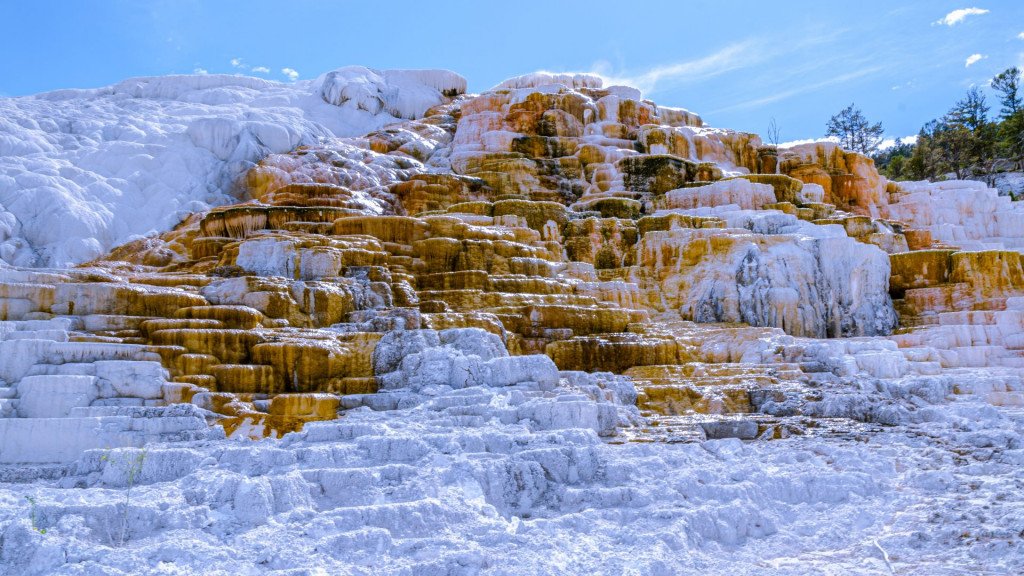
Yellowstone Travertine Terraces
Repeat visitors to the park love to drive north to Mammoth Hot Springs and see how things have changed since their last visit. Unlike most of the other geothermal features throughout the park, Mammoth Hot Springs lie outside of the caldera and instead are formed over the major inland sea that once covered much of North America. Plankton in this sea fell to the bottom and eventually became limestone. This limestone is an exceptionally soft rock and is easily broken down, allowing the travertine formations to grow and change very quickly. Anyone who enjoys geology will be mesmerized seeing these changes happening in their lifetime.
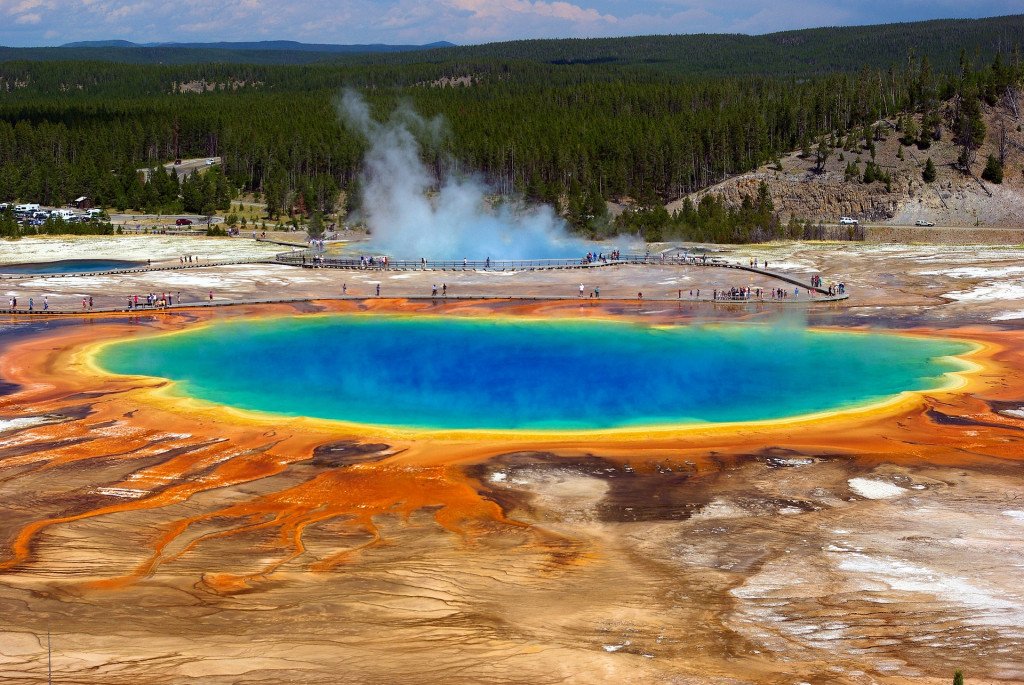
Yellowstone Hot Springs
Among the most beautiful things on earth are hot springs. They are similar to geysers, but without any constriction in their underground plumbing, allowing a steady flow of water. The most well-known geyser is Grand Prismatic Spring. Its spectacular size and stunning rainbow of colors are breathtaking. You can visit it in the Midway Geyser Basin. It is the largest hot spring in the United States and third largest in the world. You will find its gorgeous image rightfully earning a place on mugs, ornaments, and calendars in all the gift shops you visit on your trip.
Yellowstone Thermophiles
It is the colors of Grand Prismatic Spring that are most enchanting. Although some are from the minerals themselves, most of the splendid colors that delight visitors are from pigments in different microbes. These particular microbes thrive in heat and are thus called thermophiles. Visitors can use the colors of Grand Prismatic Spring to understand and remember different types of microbes and temperatures they can tolerate. Closest to the center of the hot spring where the temperature is the hottest, are light yellow microbes that feed on sulfur. Photosynthesizing bacteria live further out, in radiating regions of cooling temperatures, each an ideal habitat for microbes of a certain color.
The thermophiles of Yellowstone National Park are all microscopic but are some of the most interesting organisms on Earth. Astrobiologists study these extremophiles in Yellowstone to better understand what life off earth might be like.
Everyone who visits Yellowstone will be thrilled to see these geologic wonders but taking time to study the geology before your trip will bring your level of awe even higher when you take into account the ancient forces at work. After learning more about the geothermal features in the park, you can decide which areas you want to include in your itinerary. Even if you only visit for a day, you can enjoy years of discovery by learning more from home.
They best ways to learn more about the geology and thermophiles of Yellowstone
If you find the geology of Yellowstone fascinating, check out these resources to learn even more!
Geology of the National Parks: Yellowstone
As a former earth science teacher, I find videos to be one of the best ways to transform the complexities of geology into engrossing storytelling. This series elucidates and inspires, which is no surprise since it is a co-production of National Geographic and The Great Courses.
Take advantage of the Great Courses Plus (now Wondrium) free trial to watch the first two episodes of the series which are on Yellowstone. During the week you can also watch their Yellowstone episodes in the America From Above and The American West series. Curious travelers are forewarned, you may end up loving the Great Courses so much that you will keep your subscription. (This is one of my personal favorites and we often have the subscription!)
Seen and Unseen: Discovering the Microbes of Yellowstone
Every time I visit Yellowstone, I reread this book. It explains the diverse types of microbes that we see in the park and explores details about their habitats. It highlights each geothermal area of the park with a map, fascinating text, many color photos of the landscape, close ups of the habitat, and images captured with a microscope.
It is appropriate for readers with all levels of scientific understanding and, although it is written for adults, the photos make it visually engaging for kids too. If you are intrigued with the colors and inhospitable habitats of the microbes of Yellowstone, you will love this book!
Roadside Geology of the Yellowstone Country
Another book I start reading before each visit to Yellowstone is Roadside Geology of the Yellowstone Country. This is part of the well-loved Roadside Geology series, where readers learn about the geologic story of what they see on particular roads and, sometimes nearby hikes. The book starts with an overview and then dives into each segment of the Great Loop Road, plus the roads from each of the different entrances.
The book includes diagrams, maps, and multiple black and white photos. It is too much to comprehend while you are in the park, you won’t want to miss anything on your drive! I recommend reading it in advance of your trip and then bringing it with you to better understand each area of the park in real time. It makes great nighttime reading before each new day’s adventures.
Geology Underfoot in Yellowstone Country
Geology Underfoot is another fantastic choice for curious visitors to Yellowstone. Visual learners might prefer it because it includes so many color photos and diagrams. It also highlights many stops in the park: trails, hikes, and pullouts. Additionally, it includes an exploration of the geologic past of the Greater Yellowstone Region. It is another book worth reading in advance and bringing with you on your trip.
The Best Free Resources for Planning a Trip to Yellowstone
Tight on funds? Here are some excellent free resources that will greatly enhance your trip!
The Best Free Yellowstone Book
The best free book is the Yellowstone Resources and Issues Handbook. It is a 300-page PDF created by park staff and is overflowing with information about the park. The focus is on the natural and human history of the park, and it includes lots of color photos and maps.
The Best Free Yellowstone App
The best free app is the Yellowstone App. Be sure to download it before you arrive since cell service in the park is spotty. You will have access to interactive maps, predictions of geyser eruption times, real-time information about services in the park, and narrated stories to enjoy on your drive.
The Best Free Yellowstone Podcast
Everybody’s National Parks is my favorite podcast about our parks because they interview so many experts and I always learn something new. They have over ten episodes specifically about Yellowstone ranging from geology and wildlife, to native tribes and the history of the park. There are also trip reports and episodes on visiting with kids. It is definitely worth listening to in the months preceding your trip!
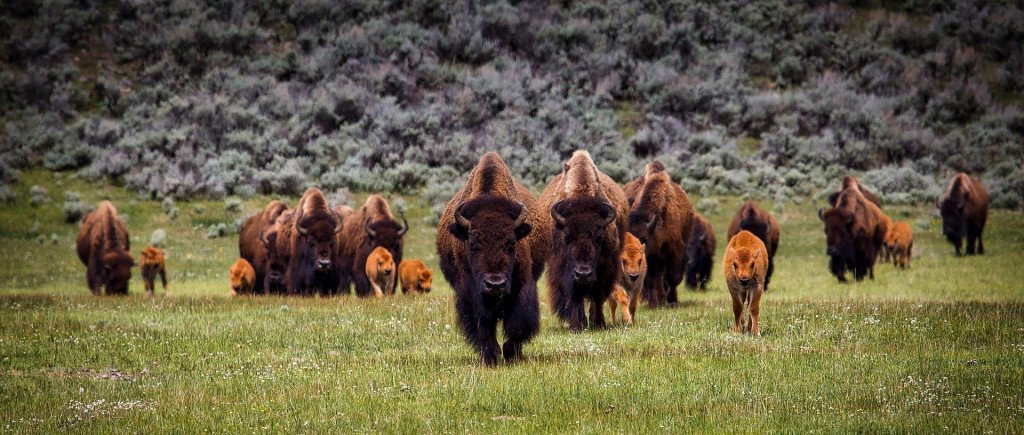
Yellowstone National Park Wildlife
Watching wildlife in the park is a thrill for all visitors. At the time the park was created, there wasn’t anything unusual about the abundant wildlife that we now marvel at. But the world has changed around the park, and for most of us, this is our best opportunity to see many of these species in their natural habitat. It is North America’s version of Africa’s Serengeti. The Greater Yellowstone Ecosystem that allows for this wonderland of animals, extends far beyond the boundaries of the National Park itself and is dependent on well managed adjacent lands.
The park boasts the largest concentration of mammals in the lower 48 and there are sixty-seven distinct species. It is the large mammals that enthrall most visitors and sightings of Yellowstone bison and elk stop visitors on the highway throughout the park. Sightings of bears, wolves, moose and the great cats, are rarer, but visitors who see them will remember their encounters for the rest of their lives.
Yellowstone National Park is also a birder’s paradise. There are nearly 300 species of birds in the park who thrive in the diverse habitats. Seeing birds of prey, including Golden and Bald Eagles is common. Trumpeter Swans, pelicans, and egrets grace the waters and wetlands, and you’ll hear varied songbirds and woodpecker hammerings throughout the park. Once again, habitat and season will determine the likelihood of what species you will encounter. It is worth a birder’s while to do research before visiting to enhance their chances of seeing their favorites.
The park is also home to 16 species of fish, 5 species of amphibians and 6 species of reptiles. Many of these are not seen by visitors but can be studied from home with the right documentaries and field guides.
10 Best Tips for Seeing Wildlife in Yellowstone
- 1. Learn about each species in advance so you know where their habitat is in the park
- 2. Dawn and dusk are your best times to see animals active
- 3. Springtime is the best season to visit to see babies
- 4. Hayden Valley, Lamar Valley, and riverbanks are likely places to see a lot of wildlife
- 5. Always keep safety in mind, we are a visitors to their homes
- 6. Stay at least 100 yards from bears and wolves and 25 yards from all other wildlife
- 7. Bring binoculars and/or a telephoto lens so you can watch from a distance
- 8. Don't feed the animals, even the adorable chipmunks who want to join your picnic!
- 9. Add extra time to your itinerary and expect to be surprised with sightings on your drive
- 10. Know that much of it is luck. You always have to save something for next time!
Top picks to learn more about the wildlife of Yellowstone
Want to learn more about the wildlife of Yellowstone? Here are some top picks for learning from home!
Yellowstone
This is my top recommendation for a documentary focused on Yellowstone National Park Wildlife. It is a three-part series by BBC Earth and the footage is phenomenal. Each 50-minute episode focuses on one of the seasons in the park.
This is a highly rated and inspirational series. There aren’t as many facts conveyed as in some other documentaries, there are no interviews, and there is a single narrator. Instead, it is a story told about the animals and geographic features as narrative with the primary focus on the amazing photography.
Even when we do experience the thrill of seeing animals in the park in person, we watch from a distance. This series offers us extraordinary close-ups we would never otherwise see. We are also offered views of animals in their habitats beyond the few days we might see them while visiting and can understand more of their life cycles and how they are interrelated with each other and the greater ecosystem.
This series is part of the incredible collection of documentaries offered by Curiostiy Stream. Check out the link below to view their affordable library with many excellent choices for curious travelers.
Wingspan
This beautiful board game with gorgeous pictures and game pieces will help you and your traveling companions learn more about the birds you will see in Yellowstone. You play as a bird enthusiast and get to learn about the birds living in your travel destinations. You collect birds of North America, many of which spend part of the year in the park.
Gameplay is slightly complicated but worth learning. It is a medium-weight, card driven engine builder for ages 10+. There isn’t direct competition with other players and points are not counted until the end of the game. This is an award-winning game for good reason and is a perfect choice for birding travelers.
In the Temple of Wolves
In the Temple of Wolves is a moving first-hand account of author, Rick Lamplugh’s time volunteering in the park with his wife. They are both former educators and were stationed over winter near Lamar Valley, prime wolf habitat. This is a contemplative book where he marvels at this astounding ecosystem and can sit with unanswered questions. We join him in watching bison, elk, eagles, and mountain lions as they interact with one another and with the wolves.
The history of Yellowstone
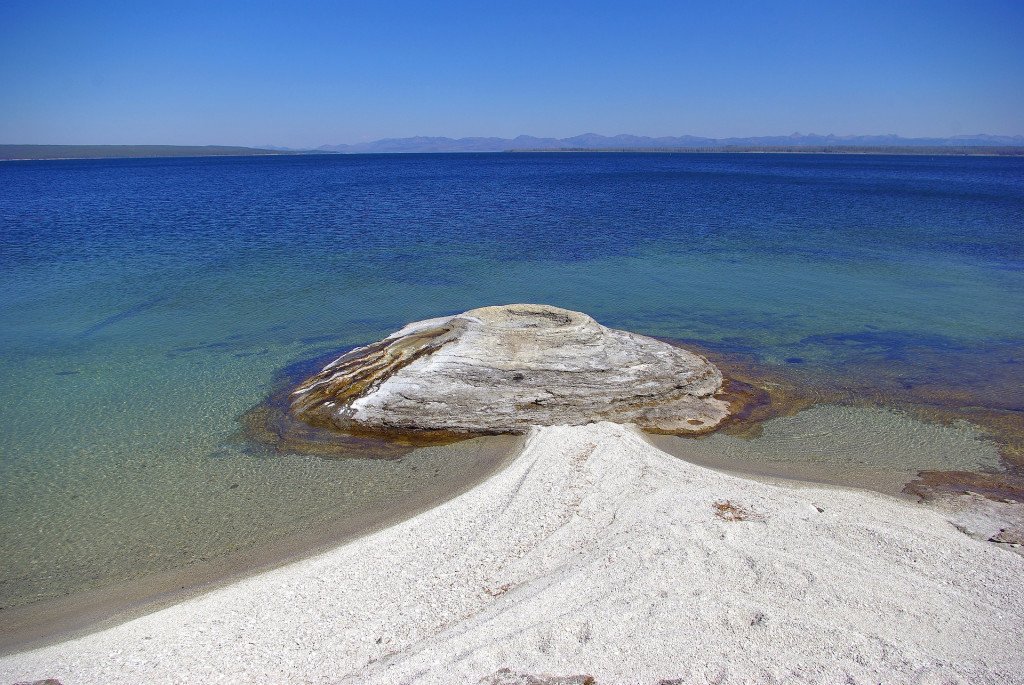
The First People of Yellowstone
Humans have been in Yellowstone for at least 11,000 years, arriving sometime after the last ice age (which ended 13,000-14,000 years ago). A fascinating stop in the northwest section of the park is Obsidian Cliff. The earliest people in the park have been quarrying obsidian here since these early days. In fact, obsidian from this cliffside is the most widely traded obsidian by hunter-gatherers in the United States. When you visit the marvelous shimmering Obsidian Cliff, you can appreciate it from both a geological and an archaeological perspective.
Yellowstone was an important area for many indigenous people. Twenty-seven different tribes have ancestral connections to the area we now know as Yellowstone. Hunting, fishing, gathering, and quarrying were common, in addition to the use of thermal waters for health and religious purposes. Archaeological sites are being studied throughout the park, with the greatest concentration around Yellowstone Lake.
As settlers from the newly formed United States began moving west, Yellowstone was also the site of tragedies and injustices against indigenous people. It was a small but important part of the journey Chief Joseph led his people on in the flight of the Nez Perce. The last of the native tribes were removed in 1882.
Top resources to learn more about archaeology in Yellowstone
To learn more about exploring the archaeology of your travel destinations, read our article, How to Create Your Own Archaeological Tour.
If you want to learn more about the first people of the Yellowstone area, here are a couple of great choices. An excellent (and free!) article about the first peoples in the park is, The Lost History of Yellowstone. It features much of the work of the author listed below, Douglas Macdonald, but in a shorter format.
This book provides a much deeper exploration of the archaeological sites and discoveries made within the park. Douglas Macdonald is an archaeology professor at the University of Montana, and he shares the most recent work in this engaging book. To protect the finds, precise locations are omitted, but we gain a much richer understanding of the earliest people, up through the recent tribes who moved through and lived within the current park boundaries. It is recommended for adults and older teens with a keen interest in the Native American archaeology of the park. You will find yourself remembering passages throughout your visit and will have a vastly richer appreciation of the people who came before you.

Yellowstone: The First National Park
For many, Yellowstone holds a special place in our hearts because it is the world’s first National Park. It is an extraordinary thing to realize the value in recognizing our most treasured natural places as belonging, not to the wealthy and powerful, not even to the residents of one state within our nation, but instead, belonging to all of us.
Fur traders began traveling through Yellowstone in the late 1700’s, but the reports that made it back to the citizens of the new nation dismissed the tales of bubbling ground and steaming waters, considering them fiction. Different expeditions continued to bring reports that were thought of as flights of fancy.
It wasn’t until a government sponsored expedition in 1871 led by Ferdinand Hayden, that the government seriously considered protecting this completely unique landscape. Although there were many esteemed scientists on this trip, it was the photographer William Jackson and the painter Thomas Moran who may have had the greatest impacts on swaying the legislature.
On March 1, 1872, President Ulysses S. Grant signed into law the creation of the Yellowstone National Park as a “public park or pleasuring-ground for the benefit and enjoyment of the people.” Today almost one hundred countries have national parks, land set aside for the enjoyment of everyone.
In 1978 Yellowstone was one of the initial twelve sites to become a UNESCO World Heritage Site, another significant step in protecting our most valuable places. To learn more about visiting these sites, check out our article, Your Guide to Visiting the World’s Most Valuable Places: UNESCO World Heritage Sites.
Top picks to learn more about the history of the park
Empire of Shadows: The Epic Story of Yellowstone
If you are looking for an in-depth exploration of the formation of the park and the important people involved in the story, Empire of Shadows is for you. Author George Black has done extensive research which he weaves into a fascinating narrative. He introduces us to characters from history whose names are laced throughout the park and surrounding areas. We see developments from these various perspectives and the complex forces at work behind the formation of the park. This is reading to enjoy from home before you leave, the book is almost 600 pages, many of which are well annotated footnotes. It is well worth the read for any history lover.
Death In Yellowstone
I asked Kris, a travel writer at Nomad By Trade to share one of her favorite resources. Kris has many helpful articles about the practical aspects of planning a trip to Yellowstone on her site. Here’s what she shared:
When planning my last visit, I picked up a book called Death in Yellowstone by Lee H. Whittlesey. It sounds morbid, but it’s actually fascinating and a great way of learning about the park. The book details all the known deaths reported in the park over more than one hundred years and presents them in an analytical way that allows the reader to learn from them. It’s especially useful in Yellowstone as its many thermal features present unique dangers that even the most experienced outdoors enthusiasts are unlikely to encounter in many other places.
The stories, though often tragic, are used as cautionary tales warning visitors to stay on the marked trails and use extra caution around the geothermal features. And those lessons are much needed as in just 3 days in Yellowstone, I witnessed a man stick his hand in a hot spring and an unsupervised kid fall off a boardwalk in an area surrounded by geysers – both were fine though I suspect the man had some minor burns on his fingers. It also helped me get a feel for the geographic layout of the park and get familiar with the different thermal areas we wanted to visit.
National Parks: America’s Best Idea
The best documentary about the formation of Yellowstone National Park, and eventually the entire National Park System, is National Parks: America’s Best Idea by Ken Burns. Yellowstone is highlighted in episode one of the six-part series. The first half of the episode features Yosemite with a focus on John Muir and is inspiring for all nature lovers. You will recall stories from the series while you visit different areas of the park, and it will add a great depth to your trip.
The whole series will have you falling more deeply in love with the National Parks of the United States. You will be inspired to continue in the long tradition of those who fought for their original creation and protection. As you would expect from Ken Burns, the episodes are brimming with engaging interviews with experts, original source documents read by talented actors, a powerful soundtrack, engrossing narration by Peter Coyote, and spectacular photography of our national parks.
Help, we are leaving tomorrow! Our top picks for quick learning
If you just found this article and are leaving tomorrow (lucky you!), we have you covered! Your first stop is the official website to check current conditions. Download this free app then check out these two resources. When you return home, come back and enjoy some of our other recommendations to enjoy a lifetime of discovery about Yellowstone National Park as your remember the amazing trip you are about to take!
The best audio tour of Yellowstone
The GyPSy guide Yellowstone and Grand Teton App is an excellent choice if you are leaving soon and haven’t had a chance to do a lot of this research yourself. It also makes a great supplement for well-researched travelers. You can learn as you drive around the park and listen based on your current location.
The most informative one-hour documentary
If you only have an hour to invest in learning more about the park before you go, watch the National Parks Exploration Series: Yellowstone. It offers the most information about the broadest range of interesting topics in the shortest amount of time. If you have plenty of time to prepare for your trip, you will appreciate how this documentary ties together many things you have already learned. Through multiple interviews with rangers and park guides we learn about the history of the park, the animals, and the geologic wonders.
More ways to learn before your trip to Yellowstone
This website is dedicated to helping travelers make the most of their time before departure. Many of our articles will be helpful to visitors to Yellowstone and provide inspiring activities to do from home.
For those with a keen interest in history or natural history, check out our step-by-step guide to using timelines to assist with in-depth learning about the natural and human history of the park.
If anyone in your party is even slightly interested in astronomy, read our article, How to Plan Stargazing Trips. Yellowstone skies are very dark and you can see the Milky Way! Whether you are helping a city dweller find the Big Dipper, or you are packing your favorite scope, the park is a fantastic place to for everyone who loves to look out to the cosmos.
Hopefully, you will be taking many photos while you are in the park. We’ve got a super helpful article on how to improve your landscape photography skills from home before your trip. There are even tips on using your phone’s camera and traveling with non-photographers. If you start practicing now, you’ll be able to capture photos to cherish for a lifetime.
Enjoy your trip to Yellowstone
When you are finally in the park, enjoy! You’ll find the soundtrack to the park is oohs and ahhs, it is a land beyond superlatives! You will be driving through some of the prettiest scenery you have ever seen only to turn the corner to see an otherworldly and extraordinary site! This will continue throughout your entire trip and, because these experiences are so unique, they will live on in your memory forever.
It is my most sincere hope that some of the resources you found in this article enhance your time in the park! The deeper understanding I have gained from them created transformative experiences for me on my own trips and I wish the same for you.
Have you been to Yellowstone or do you plan to travel there? I would love to hear about it in the comments! Do you have a resource you recommend to other travelers? Please tell us below.
Erica
Let's Connect
I’d like to send you a free gift!
The Curious Traveler’s 5 Step Guide to More Meaningful Trips









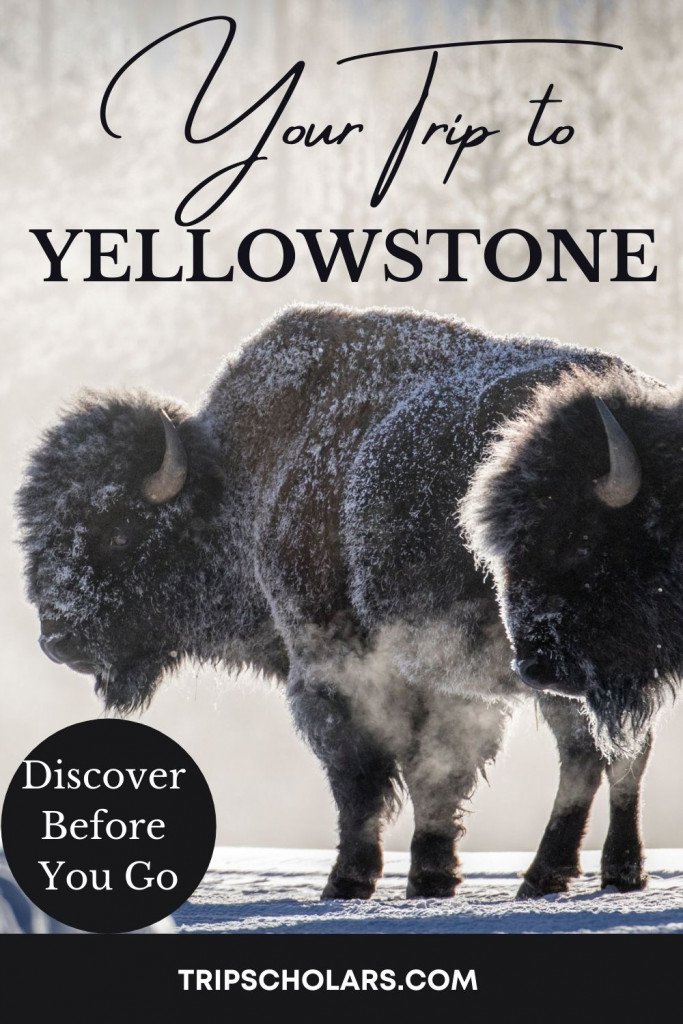
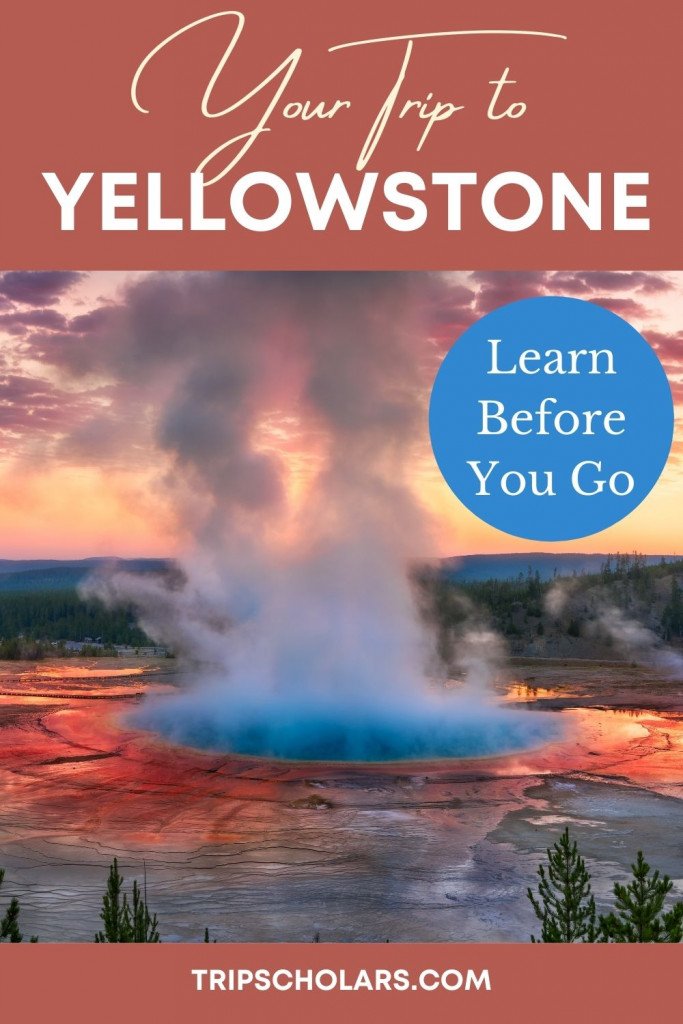
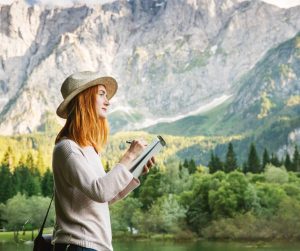

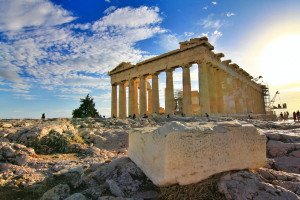
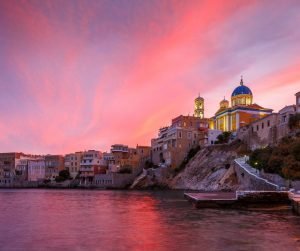

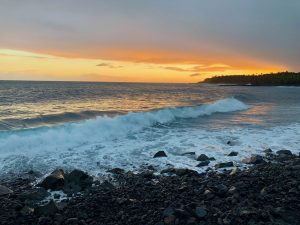

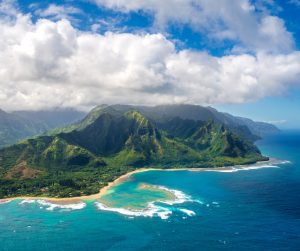
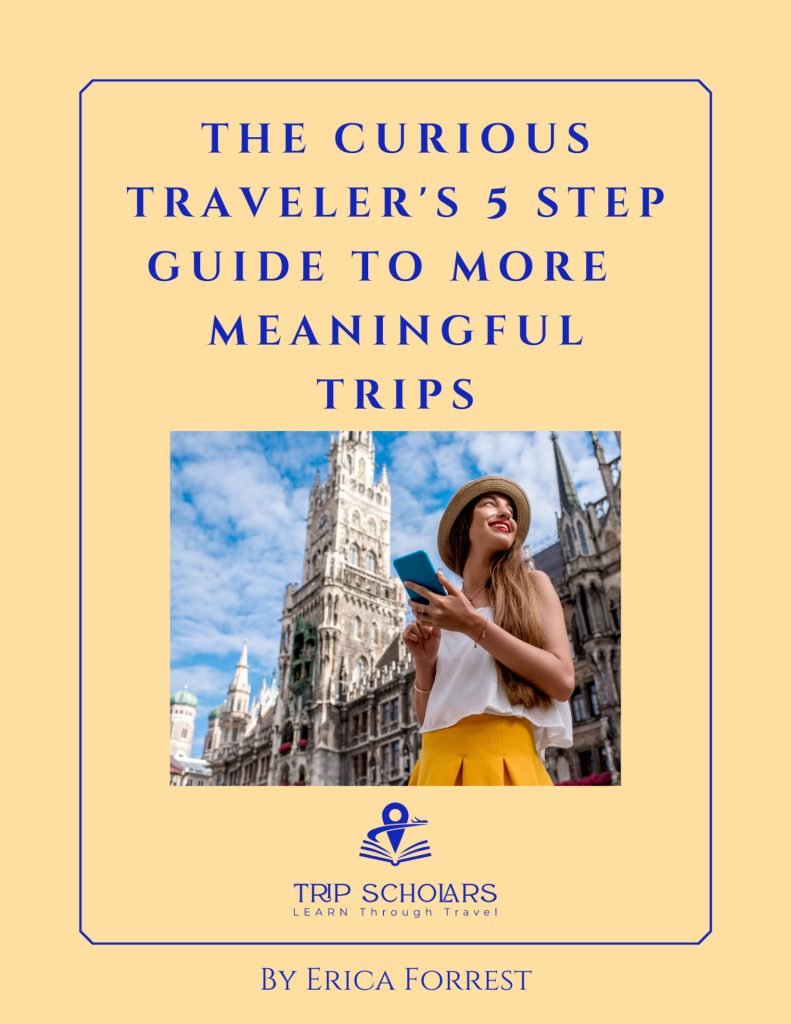
10 thoughts on “The Ultimate Guide to Planning A Trip to Yellowstone”
Seriously, this post on how to learn about Yellowstone NP is amazing! I’m hoping to take my family there next year and will put some of these resources on our reading and watching list.
Thank you Catherine! I love the park and hope anything you read or watch beforehand makes your trip even better!
Yellowstone is pretty high up on my list of national parks I’d love to visit! I love learning about different places so thanks so much for the comprehensive guide — definitely saving for future planning purposes! :]!
You are welcome, it was a labor of love to write this. I am excited for your future trip, you’ll have an amazing time!
I absolutely fell in love with Yellowstone when we visited a few years ago. We camped there but I must admit we didn’t do an in-depth research prior to our visit. I want to return and I’m sure I’ll read more about it before I go back. Especially because I want to visit the park in winter which I agree would require a lot more planning!
That is fantastic that you were able to visit, I’m glad you had such a wonderful time! Good luck with your winder visit– it will be incredible!
What a fascinating and beautiful place! I would definitely like to get back there, especially armed with new knowledge!
I hope you are able to visit again soon!
I can’t help feeling disappointed when I find out I’d missed seeing something of interest, or learning something important about a place, after I’d visited. You’ve nailed it with this post. It’s a fabulous resource. I’ve never been to Yellowstone (I’ve heard about it) and didn’t realize how diverse it is… certainly not a place to breeze through in a hurry. Thank you for your thorough research and compiling an excellent one-stop resource.
I agree 100%, Anne! Thanks for the kind words, I am so glad you found the post helpful. I love Yellowstone and enjoyed writing about the many ways we can learn more about this astounding place. I hope you are able to visit someday!